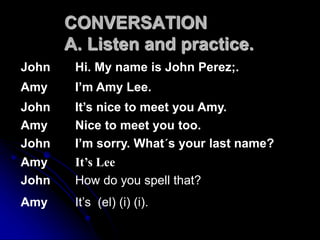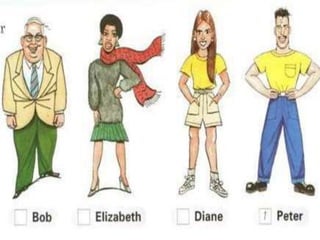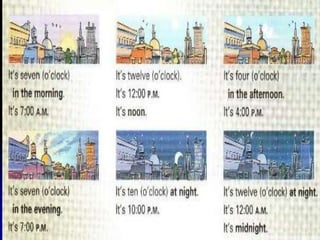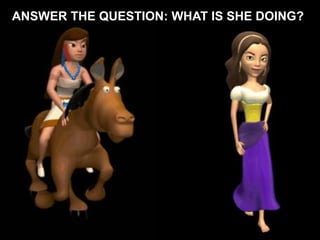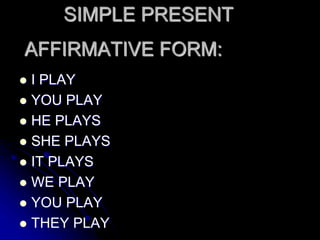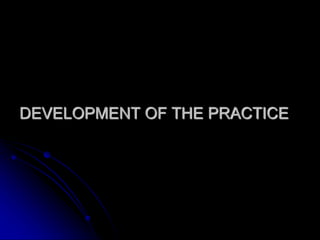UNH CYCLE I - II.ppt
- 1. MINISTERIO DE AGRICULTURA RONALD ALMONACID VILLA ENGLISH TEACHER BASIC LEVEL
- 2. CYCLE I -II
- 3. IMPORTANCIA La importancia del aprendizaje del inglés radica en que la literatura cultural, científica y especializada muchas veces se encuentra publicada en dicho idioma así como la información más actualizada de los últimos avances de la ciencia y la tecnología. El idioma inglés es considerado el idioma universal y en congresos, eventos, ferias internacionales es el idioma oficial que se utiliza con vista a romper barreras lingüísticas favorecidas por intercambios educativos y profesionales. Es importante aprender Inglés también por que conseguimos mayor horizonte cultural, de conocimientos o distracción, relaciones sociales más extensas y además útil por ser una aspiración de un amplio sector de la sociedad emprendedora y competitiva
- 5. The alphabet
- 6. Reglas para la pronunciación en Inglés Si a la vocal (a,e,i,o,u) le antecede dos consonantes este suena como en el español. Travel Character Psicology Secretary
- 8. Hello / Hi Good morning Good afternoon Good evening Good night Good bye See you later See you tomorrow How are you? fine thanks How’s it going? = not so good.
- 9. CONVERSATION A. Listen and practice. John Hi. My name is John Perez;. Amy I’m Amy Lee. John It’s nice to meet you Amy. Amy Nice to meet you too. John I’m sorry. What´s your last name? Amy It’s Lee John How do you spell that? Amy It’s (el) (i) (i).
- 10. DEMONSTRATIVES THIS are divided into two groups SINGULAR PLURAL THESE THOSE THAT
- 11. THIS - THAT • Los demostrativos THIS and THAT se utilizan con sustantivos singulares. El demostrativo THIS se debe utilizar con un sustantivo que esté cerca, en ubicación, del emisor del mensaje. • THIS NEAR THE SPEAKER: • este masculine singular • esta feminine singular
- 12. THIS - THAT • El demostrativo THAT se debe utilizar con un sustantivo que esté lejos, fuera del alcance, del emisor del mensaje. • THAT FAR FROM THE SPEAKER: • ese masculine singular • esa feminine singular
- 13. • Entonces debes haber notado las semejanzas y diferencias entre THIS y THAT. Ambos se utilizan con sustantivos singulares, con el verbo to be “is”. THIS se utiliza cuando el sustantivo está cerca del emisor y THAT cuando el sustantivo está lejos del emisor. THIS - THAT
- 14. THESE - THOSE • Los demostrativos THESE and THOSE se utilizan con sustantivos plurales. El demostrativo THESE se debe utilizar con los sustantivos que estén cerca, en ubicación, del emisor del mensaje. • THESE NEAR THE SPEAKER: • estos masculine plural • estas feminine plural
- 15. THESE - THOSE • El demostrativo THOSE se debe utilizar con sustantivos (plural) que estén lejos, fuera del alcance, del emisor del mensaje. • THOSE FAR FROM THE SPEAKER: • esos masculine plural • esas feminine plural
- 16. THESE - THOSE • Examples: THE ORANGES ARE NEAR THE WOMAN. THE ORANGES ARE FAR FROM US. THOSE ORANGES ARE DELICIOUS. THESE ORANGES ARE BIG.
- 17. • Entonces, THESE y THOSE se utilizan con sustantivos plurales, con el verbo to be “are”. THESE se utiliza cuando los sustantivos están cerca del emisor y THOSE cuando los sustantivos están lejos del emisor. THESE - THOSE
- 18. REMEMBER: • Trate de insertar el vocabulario aprendido en temas de la vida cotidiana para que los practique constantemente. Los demostrativos también utilizan el verbo To Be en dos de sus formas: IS, ARE. This y That utilizan is porque trabajan con sustantivos en singular y These y Those utilizan are porque trabajan con sustantivos en plural. • Practica un poquito todos los días. • Ingresa a la Biblioteca Virtual.
- 19. • What’s this? • It’s a dog.
- 22. PLURAL OF THE NOUNS To form the plural of the nouns, generally we need add to the noun the letter “ s”, similar to the spanish. Example: dog + s = dogs, cats, cars, carrots, oranges, bananas, pencils, tables, chairs, umbrellas, windows, doors, etc.
- 23. 1.-when the noun finish in: s, sh, ch, x, o; they form the plural adding “es”. Brush - brushes Bus - buses Match -matches Box - boxes Potato- potatoes Kiss - kisses
- 24. 2.-If a noun end in -y change the y to “ies” Baby - babies Country - Countries Factory - factories Lady - ladies Story - stories Diary - diaries Fly - flies Cherry - cherries
- 25. 3.- If the noun finish in –f or –fe they form the plural change –f or –fe by “ves” Leaf - leaves Knife - knives Wolf - wolves Thief - thieves Shelf - shelves
- 26. 4.- There are some nouns that have different forms in singular and in plural. Man - men Woman - women Child - children Mouse - mice Foot - feet Tooth - teeth
- 27. 5.- There are some nouns that have the same form in plural and in singular. Fish = fish Sheep = sheep
- 28. 6.- In English there are some nouns that don’t have plural only singular. Hair Homework Advice Information Furniture Money spaguetti
- 29. 7.- In English there are some nouns that don’t have singular only plural. People Police Pijamas Goods tights
- 30. Money Diaries Books Roosters Pyjamas Men Advice Lemons Babies Tights Sheep Fish coutries Teeth Children Information Police Cuando un verbo acaba en x, o, s, sh ó ch, se añade “es” Si el verbo acaba en “y” precedida de consonante se forma el plural cambiando la “ y” por “ ies” Algunas palabras que terminan en F o Fe forman el plural cambiando la f o fe por “ves” Algunos tienen su plural diferente De otros el plural es el mismo Otros no tienen plural Otros no tienen singular
- 33. Personal verb to be pronouns I YOU HE SHE IT WE YOU THEY AM ARE IS IS IS ARE ARE ARE
- 35. Personal verb to be adjectives pronouns I YOU HE SHE IT WE YOU THEY AM ARE IS IS IS ARE ARE ARE HAPPY SAD GOOD BAD FAST SLOW FAT NEW
- 47. Prepositions of place WHERE IS THE CELLPHONE? The cellphone is in the table on between under behind next to in front of
- 48. Prepositions of place The cellphone is in the table on between under behind next to in front of
- 52. Where is the cathedral? (behind) Where is the hotel? (between) Where is the disco? (next to) Where is the city hall? (on) Where is the Sensano Gallery? (in) Where is the woman defense?(behind) Where is the telefònica? (between) Where is the book store? (next to) Where is the woman defense? (in front of) Where is the shoe store? (behind) Where is the gym? (between)
- 63. What is she wearing? She’s wearing a black jacket, a purple blouse, blue and gray skirt, light blue socks and black shoes.
- 64. What is she wearing? = She is wearing …………………………… …………………………… ………….………………… ……………….……………
- 65. • What is he wearing? = He is wearing …………………………… …………………………… ………….………………… ……………….……………
- 74. Personal verb to be pronouns I YOU HE SHE IT WE YOU THEY AM PLAYING TENNIS. ARE PLAYING IS PLAYING IS PLAYING IS PLAYING ARE PLAYING ARE PLAYING ARE PLAYING
- 75. ANSWER THE QUESTION: WHAT IS HE DOING?
- 76. ANSWER THE QUESTION: WHAT IS HE DOING?
- 77. ANSWER THE QUESTION: WHAT IS HE DOING?
- 78. ANSWER THE QUESTION: WHAT IS HE DOING?
- 79. ANSWER THE QUESTION: WHAT IS HE DOING?
- 80. ANSWER THE QUESTION: WHAT IS HE DOING?
- 81. ANSWER THE QUESTION: WHAT IS HE DOING?
- 87. ANSWER THE QUESTION: WHAT IS SHE DOING?
- 88. ANSWER THE QUESTION: WHAT IS SHE DOING?
- 89. ANSWER THE QUESTION: WHAT IS SHE DOING?
- 90. ANSWER THE QUESTION: WHAT ARE THEY DOING?
- 91. ANSWER THE QUESTION: WHAT ARE THEY DOING?
- 94. UNIT 6
- 95. AFFIRMATIVE FORM: I PLAY YOU PLAY HE PLAYS SHE PLAYS IT PLAYS WE PLAY YOU PLAY THEY PLAY SIMPLE PRESENT
- 96. DO I PLAY? DO YOU PLAY? DOES HE PLAY? DOES SHE PLAY? DOES IT PLAY? DO WE PLAY? DO YOU PLAY? DO THEY PLAY? INTERROGATIVE FORM:
- 97. NEGATIVE FORM: I DON’T PLAY YOU DON’T PLAY HE DOESN`T PLAY SHE DOESN`T PLAY IT DOESN`T PLAY WE DON’T PLAY YOU DON`T PLAY THEY DON’T PLAY
- 141. UNIT 8
- 143. What do we need to prepare ceviche? = We need some fish, = We don’t need any
- 144. WH-Q + do/does + Subject + Adv. Freq + Verb + C? Do/Does + Subject + Adv. Freq + Verb + Compl.
- 145. A: What do you usually have for breakfast? B: Well, I often have coffee, cereal, and juice. A:Do you ever eat breakfast at work? B: I sometimes have breakfast at my desk. A: Do you usually eat rice for breakfast? B: No, I hardly ever have rice. WH-Q + do/does + Subject + Adv. Freq + Verb + C? Do/Does + Subject + Adv. Freq + Verb + Compl.
- 158. I.-INSTRUCTION: Re-write the dates using the correct punctuation tuesday january 4 2013_______________________ monday june 2 2003 _________________________ friday december 2 2011 ________________________ wednesday december 31 2013 __________________ saturday may 23 2009 ________________________ sunday july 4 1999 ________________________
- 184. DEVELOPMENT OF THE PRACTICE








